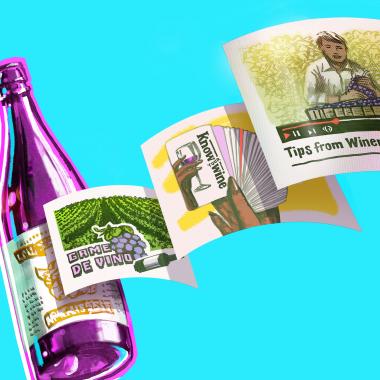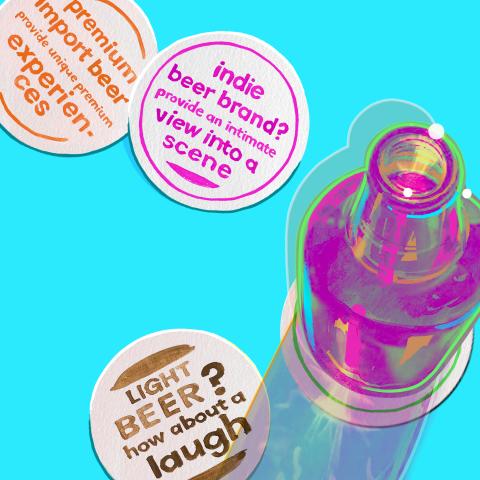
You’re seated at a rustic picnic table. A handsome sommelier with slicked-back hair and an ambiguous continental accent gently places two identical stems in front of you. In each glass rests 5 ounces of visually identical pinot—dainty in body, luscious in color.
The sommelier instructs you to choose a wine but without getting a taste. He grants you a sniff, but you perceive no difference. You ask for the name of each, but you haven’t heard of either, and they both sound equally lovely. Just before you give up and choose one at random, the man says, ‘Oh, by the way, the wine on the right just launched a TV ad campaign this week. Let me pull it up for you.” “No need,” you say. “I’ll have the one on the left.”
For wine, as with law firms, restaurants and sports cars, the more likely it is to advertise, the less likely we are to covet it. How can the entire discipline of advertising be off-limits to a $63 billion-a-year business?
Wine is the second most popular drink in the U.S. behind beer. But the beer industry spends about $1.5 billion annually on advertising in the U.S., while winemakers spend a little over $100 million. That’s less than even cider brands spend. And it’s not because wine drinkers are some hard-to-reach niche of elites—46 percent of Americans have consumed wine at home in the past three months, per Mintel. You could throw a dart at a map and hit a wine drinker.
To receive a list of content idea thought starters for winemakers, reach out here.
The Competition Is Crushing
Advertising commoditizes whatever it touches, which is a bad fit for products or services that depend on an air of authenticity, experience or luxury. Wine is a mass-market product that must avoid looking mass to the market. The category has clearly performed well for years without relying on advertising, but I fear that luck is running out. Winemakers are going to need a way to build their brands now.
While 10 companies still represent 63 percent of multi-outlet sales of wine, there are 11,000 wineries in the U.S. vying for attention. Private-label sales grew 52 percent in the year ending in September 2020, according to Mintel. And consumers still have no idea how to choose a wine: 35 percent say they stick with the same varietal, and 29 percent with the same brand. The category has plunged consumers into a paradox-of-choice vortex where they can see no difference between all the options, so they put on their own blinders.
Furthermore, wine is quickly commoditizing. Consumption of boxed wine increased from 16 percent in 2019 to 20 percent in 2020. For canned wine, we see a jump from 9 percent to 17 percent. According to Mintel, 13 percent of wine drinkers report switching to alcoholic seltzers or other ready-to-drink beverages. Consumers are starting to see wine as “just another drink in a can,” and the industry is playing right into it. Rather than fighting back with brand-building and differentiation, it’s wading into a pool of piranhas, fighting beer and spirits brands for casual, on-the-go occasions.
But perhaps wine doesn’t need a fundamental shift. Perhaps brands don’t need TV commercials to build awareness or differentiation. Perhaps they don’t need aluminum cans to make their products accessible. It’s time to imagine what a real investment in content marketing could do. (And it needs to be more than recipes, Instagram photos or the occasional blog post about the season’s harvest.)
Pair Your Brand with a New Content Strategy
Thirty-three percent of consumers say they’d like to improve their knowledge of wine. What’s stopping them? It’s not like there’s any shortage of wine apps or YouTube videos out there. But this content is always just a forgettable procession of facts: this varietal from this region with these tasting notes. It doesn’t really educate consumers. I wish someone would gamify the process of learning the domaines and chateaus of France the way Duolingo gamifies learning a language. I’d love to see an immersive experience that simplified the winemaking process. I’d love to see a video series that brought me into a sommelier’s thought process in designing a menu.
So little of the world of wine content is created by the actual winemakers. We don’t have to think of accessibility as just portability. Use content to make the product more relatable and approachable. Teach a casual and fun free wine class on Zoom. Tell the story of your vineyard through animation. Take small groups of consumers on digital tours through the vineyard. Why are none of the top wine podcasts created by the actual winemakers?
Beyond education, do something for your audience that it genuinely needs. People don’t need your Dungeness crab recipe (unless it’s actually famous). They need inspiration, escapism, social connection and validation. Put wine in a different context than food and travel for a change. Create a women-in-technology forum or speaker series on Thursday nights. Or women in stand-up comedy. Create a thought leadership hub around your brand’s role in reducing the industry’s environmental impact. Tell the untold personal stories of winemakers around the world.
Winemakers can also think about content from a B2B perspective, so to speak. What can they provide restaurateurs, sommeliers and distributors to make life easier or more profitable? Food and wine trends or research studies? An app that makes memorizing tasting notes easier for staff? Attractive wine description cards to give out to customers? Ultramemorable, quick-hitting videos that tell the story of each new wine so staff can give customers more than tasting notes?
Start with one idea and a measurement plan. Before you pour $20 million into promoting content around the internet, just take a sip first. Swirl it around. See if the idea has some legs. If it starts to do something meaningful for your business, build up slowly. The beauty of content, unlike advertising, is that you can always spit it out and try something else.

